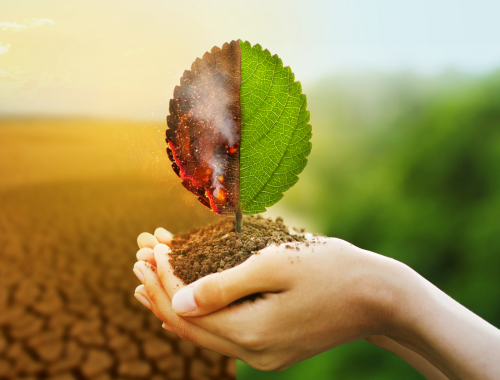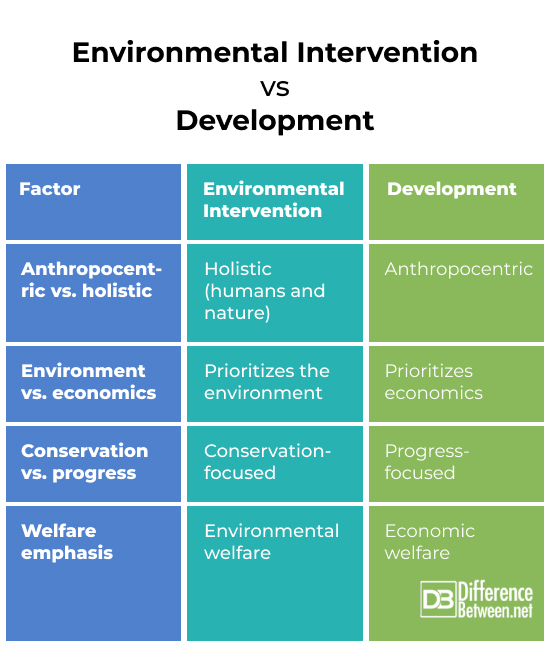Difference Between Environmental Intervention and Development

Environmental intervention
What is the meaning of environmental intervention?
Environmental intervention refers to intentionally acting to prevent a particular environmental change. This can be done through technological means. A technological example of environmental intervention is using airplanes to release particles into the atmosphere to seed clouds to lower the temperature of a region. Interventions can also be biological in nature. A biological example of environmental intervention might be planting trees to lower temperatures by creating more shade or to absorb atmospheric CO2.
What is an example of environmental intervention?
Another example of environmental intervention would include one of the proposed approaches for reducing the impact of rising ocean temperatures on coral reefs. Because coral reefs can only tolerate certain water temperatures, increasing ocean temperatures due to climate change has imperiled coral reefs. One suggested intervention is to pump cooler water from deeper in the ocean to the surface to cool the surface waters in which coral reefs exist.

Development
Environment and development as concepts
The environment refers to the complex physical, chemical, and biotic factors that influence the survival and nature of an organism or ecological community. The physical environment of the planet includes the oceans, continents, and atmosphere. The biotic environment includes the numerous organisms that inhabit the planet and form a network of interconnected ecosystems. The chemical environment would include the geochemical and biogeochemical cycles, such as the carbon cycle and the nitrogen cycle, which maintain a steady supply of nutrients throughout the biosphere.
Development, in the context of the international economy and living standards, refers to the process by which national economies and living standards increase in relative complexity and prosperity. The national state of development for a country is usually measured in terms of per capita income compared to other countries. Countries with higher per capita income are generally considered to be more developed, though this is not always the case.
What is the difference between environment and development?
The environment is an essential factor in the well-being and flourishing both of ecosystems and human societies. The ease with which necessities, like food, energy, and raw materials, can be extracted from the environment without over-exploitation is a significant, though not solitary, determiner for the prosperity of a human society or the health of an ecological community. Development, on the other hand, is the process by which human societies grow in prosperity and standard of living. Essentially, the environment is the setting of human societies and ecosystems, whereas development describes how human societies grow, flourish, or suffer in their environments.
What are three examples of the environmental impacts of development?
Development has had many major impacts on the environment. Three examples are biodiversity loss, climate change, and pollution.
Biodiversity loss refers to the loss of the variety of different types of living organisms in a given ecosystem. Development has involved converting wilderness lands, such as forests and grasslands, into croplands, which usually have fewer environmental niches for different organisms to inhabit. Because of the loss of these niches, many organisms end up going extinct, leaving only the ones who can survive in the more limited niches available in human-made landscapes, such as farmland.
Anthropogenic climate change is caused by the rise of the average global temperature due to greenhouse gas emissions from human activity. Development has resulted in an overall increase in greenhouse gas emissions from burning fossil fuels to power vehicles, to provide electricity, and to produce consumer goods. The effects of anthropogenic climate change from greenhouse gas emissions are seen, for example, in the shrinking of ice caps and glaciers in mountain ranges across the planet.
A third environmental impact of development is pollution, which has significant health risks for human societies and is also destructive to ecosystems. Much of the pollution that is threatening to humans is from aerosol particles released by the burning of fossil fuels during the operating of vehicles, industrial production, and electricity generation.
Similarities between environmental intervention and development
What is the relationship between environmental intervention and development?
Environmental intervention and development are related in that further development will likely lead to further environmental interventions to mitigate the environmental effects of development.
What is an example of an environmental factor in growth and development?
One example of an environmental factor that impacts development is soil health. This is especially true for economies largely dependent on agricultural exports. Soil that is depleted in organic matter because of overuse will slow down economic development since it will reduce crop yields and therefore profits from crop yields as well as available food. This will reduce prosperity and the quality of life in the associated country or region.
Differences between environmental intervention and development
Although there are important ways that environmental intervention and development overlap and have similar goals, there are also important differences and divergences. These include the following.
- Environmental intervention is focused both on human and non-human well-being, whereas development tends to be entirely human-focused.
- Environmental intervention prioritizes the welfare of the environment, whereas development prioritizes the economic improvement of human societies.
- Environmental intervention is focused on preventing a process, whereas development is focused on advancing a process.
- Environmental intervention can be done, but is not necessarily done, with economic welfare in mind, whereas development must be done with economic welfare in mind.
Environmental intervention vs. development

Summary
Environmental intervention involves actions by humans to prevent specific environmental changes, such as desertification or climate change. This can be done through technology, for example, through geo-engineering techniques. It can also be done through biological means, for example, planting trees. Development refers to the process by which human societies increase their economic prosperity and standard of living over time. Environmental intervention and development are related in that some environmental interventions are and will increasingly be necessary for development. Economic development is not possible if the environment is not in a state in which energy, raw materials, and food can be effectively extracted from the environment for human use without threatening the integrity of the environment. On the other hand, they also differ in their focus and goals. Environmental intervention is environment-focused, concerned with conservation, and prioritizes the welfare of both human and non-human life. Development, on the other hand, is economy-focused, concerned with progress, and more anthropocentric in emphasizing human welfare over environmental welfare.
- Difference Between Environmental Performance Index and Development - November 24, 2023
- Difference Between Environmental Intervention and Development - November 8, 2023
- Difference Between Eco Efficiency and Eco Effectiveness - September 18, 2023
Search DifferenceBetween.net :
Leave a Response
References :
[0]Gomez-Echeverri, Luis. "Climate and development: enhancing impact through stronger linkages in the implementation of the Paris Agreement and the Sustainable Development Goals (SDGs)." Philosophical Transactions of the Royal Society A: Mathematical, Physical and Engineering Sciences 376.2119 (2018): 20160444.
[1]Hossain, Md Zahid. "Farmer's view on soil organic matter depletion and its management in Bangladesh." Nutrient cycling in Agroecosystems 61.1-2 (2001): 197-204.
[2]National Academies of Sciences, Engineering, and Medicine. A research review of interventions to increase the persistence and resilience of coral reefs. 2018.
[3]Landrigan, Philip J., et al. "The Lancet Commission on pollution and health." The lancet 391.10119 (2018): 462-512.
[4]Myint, Hla and Krueger, Anne O. "economic development". Encyclopedia Britannica, 28 Aug. 2023, https://www.britannica.com/money/topic/economic-development. Accessed 2 September 2023.
[5]Siddik, M., et al. "Current status and correlation of fossil fuels consumption and greenhouse gas emissions." Int. J. Energy Environ. Econ 28 (2021): 103-119.
[6]Britannica, The Editors of Encyclopaedia. "environment". Encyclopedia Britannica, 5 Jun. 2023, https://www.britannica.com/science/environment. Accessed 2 September 2023.
[7]Thompson, John N., Thompson, Michael B. and Gates, David M. "biosphere". Encyclopedia Britannica, 11 Aug. 2023, https://www.britannica.com/science/biosphere. Accessed 2 September 2023.
[8]Thompson, Lonnie G. "Climate change: The evidence and our options." The Behavior Analyst 33 (2010): 153-170.
[9]“What is the human impact on biodiversity?” Royal Society, n.d., https://royalsociety.org/topics-policy/projects/biodiversity/human-impact-on-biodiversity/.
[10]Image credit: https://www.canva.com/photos/MAECGPCeNxg-climate-change-and-environmental/
[11]Image credit: https://www.canva.com/photos/MAFKkMagEHY-nature-sustainability-and-earth-soil-growth-showing-teamwork-green-energy-and-a-eco-friendly-environment-save-the-planet-and-environmental-development-with-clean-net-zero-carbon-footprint-together/
